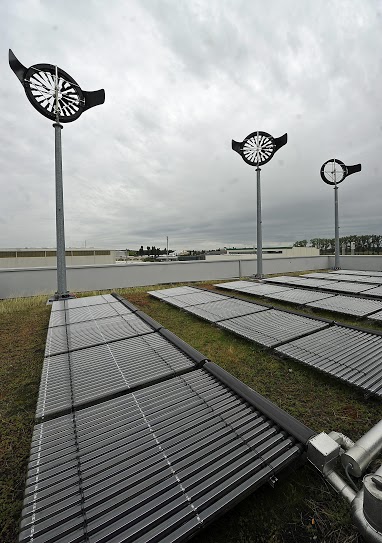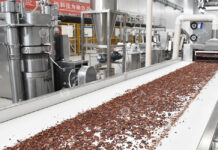
No resources are wasted in the SolarWind building that breathes dynamism into an entire business park
In the middle of the countryside, a few kilometres from the Belgian border, the SolarWind building rose from the ground in 2012. This office building is not like any other; here, a green wall adjoins a facade covered in photovoltaic panels. Rainwater is collected for use in the bathroom facilities and, on the roof, three Wind turbines produce part of the electricity required, while combined thermal and photovoltaic solar panels account for 70% of the building’s hot water needs.
In winter, a biomass power plant also contributes to the task and operates in a very specific manner: “The biomass is supplied by our neighbour, who brings over wood pallets,” says Romain Poulles. The building’s co-designer has installed three hives on the roof surrounded by aromatic plants. “We produce about 70 kg of honey per year,” he says proudly.
Creating an energetically self-sufficient building is the goal achieved by the real estate investor. “We had already done it previously for small buildings. Here we did for a large, 10,000 m² construction.” The interior of the building, wrapped in multiple layers of insulation, boasts all mod cons with a green touch. The carpet is recyclable and has a fibre which binds the fine particles to its surface.
“New buildings are increasingly hermetic,” states Romain Poulles. And to avoid having to heat or cool the building excessively, it is important to temper it. In addition to a Canadian well system that exploits the constant temperature of the ground, 98 geothermal wells are connected to heat pumps which heat the air in winter, and cool it in summer. “Our goal is to reduce consumption without reducing comfort.”
Analyse to regulate
Obviously, this recipe is attractive, as 95% of the available offices have already found tenants. Just under 20 companies are housed in SolarWind, with one special characteristic: they do not pay common energy charges. Their only utility bills relate to their own devices, and go through a green energy central purchasing body.
And, to further reduce the rating, a “Smart analyser” has been installed. The device measures and details all the occupants’ consumption. “Once we measure, we can change our behaviour,” states Romain Poulles. The consumption curves are displayed on a screen: I.T. represents half of the private power consumption, but its share used to be higher. By convincing the occupants to turn off their computers on weekends, for instance, the result is clearly displayed on the charts. As for soda-machines, their share of energy consumed has fallen from 15% to 7%. These “poorly insulated refrigerators” have seen their temperature rise from 7°C to 9°C.

Contagious Economies
“Smart Analysers” have also been installed in other companies within the EcoParc Windhof, where the SolarWind is located. “We have reduced the average consumption of the buildings forming part of the EcoParc by 20-25%”, says Romain Poulles. Today, the Ecoparc extends across 40 hectares, with 150 companies in sectors ranging from IT distribution, to crafts and services dedicated to the 2,000 site employees, such as nurseries, restaurants and gyms. When designing the building, the real estate investor asked his neighbours about their infrastructure requirements for the park. Over time, a real dynamic was born, with joint events and initiatives.
“The local authorities also see it as an advantage because they have contacts who get something in return from their users.” Internal studies have allowed a second access and exit route to be installed at the park, not to mention incentives for soft mobility, such as car sharing and a better bus service.
This is undoubtedly SolarWind’s weakness: although the building is energy independent, resources have to be expended in accessing it. Nevertheless, the concept is perfectly reproducible anywhere, including urban areas. The triple energy certification of the building is a strong argument, but it is not the only one. “It doesn’t necessarily cost more to build, especially from a lifetime perspective,” says Romain Poulles.
“Here, the over-investment linked to sustainable development is in the region of 3%, but this is neutralised by offsetting.” For example, the facade of photovoltaic panels also serves as sun protection. Everything fits into an environment inspired by the “Cradle-to-Cradle” philosophy.
Its goal? To ensure that the collective benefit is greater than the sum of the individual benefits. With a host of facilities that would be excessively costly for a single SME mutualised within the EcoParc, it seems that the bet has paid off.
By CATHERINE KURZAWA























